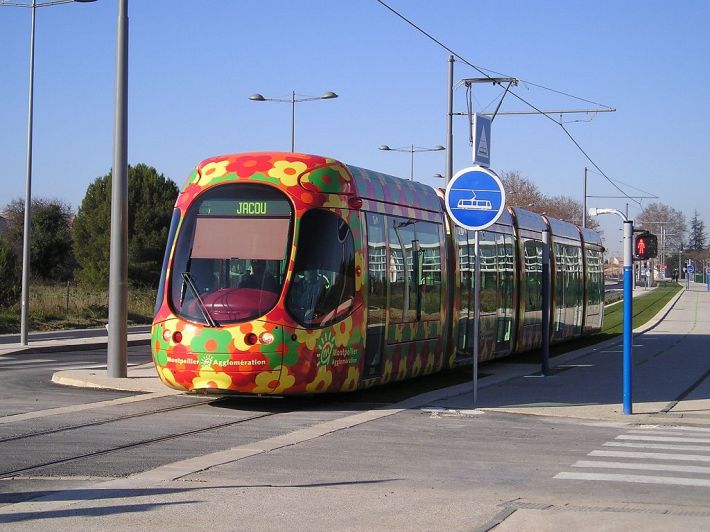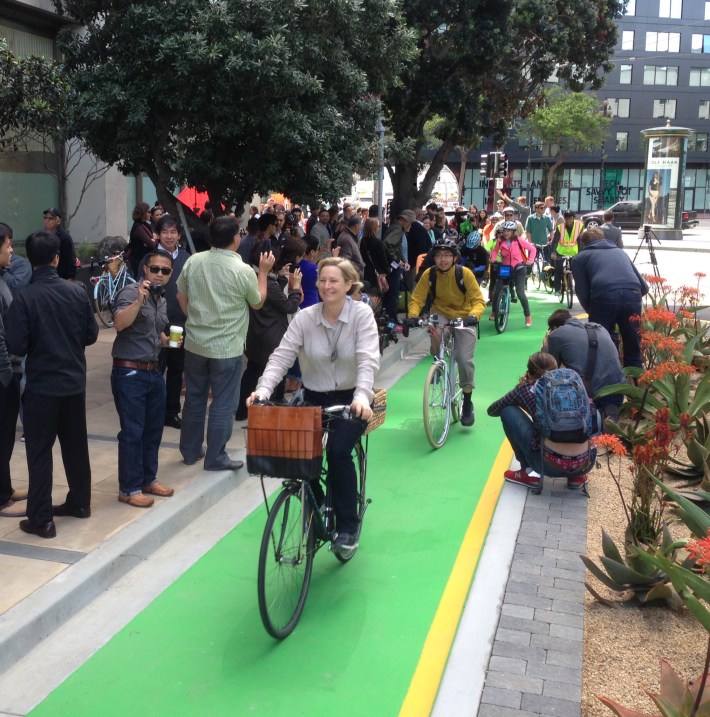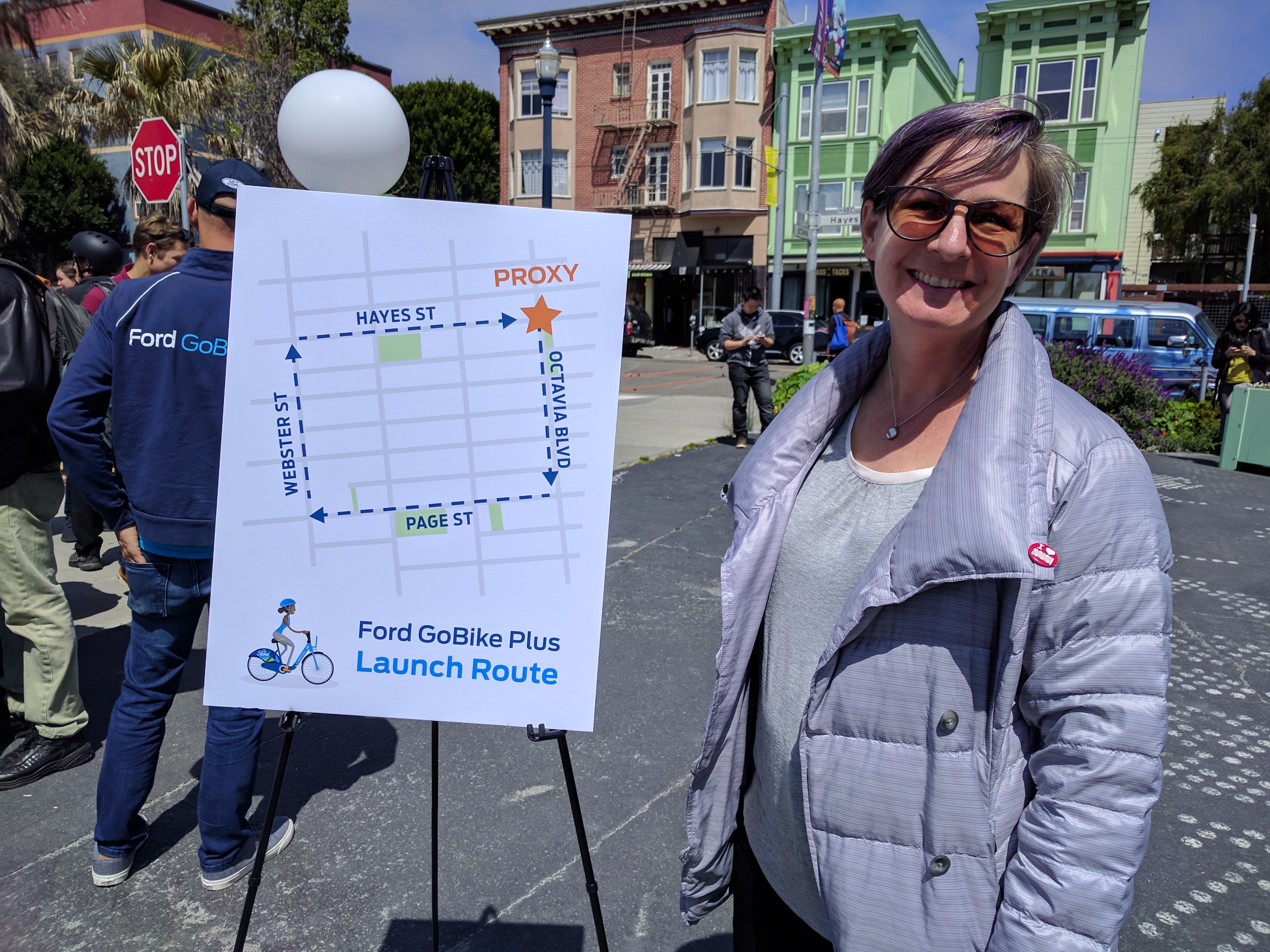Cheryl Brinkman was appointed to the SFMTA board in 2010, elected Vice Chair in 2012, and elected Chair in 2017. As such, she's been instrumental in SFMTA decisions for many years--and has a long history advocating for safer streets and better transit. Notably, in a key lone-wolf vote last year she paved the way for a Caltrain funding measure that otherwise would have failed.
From her bio page on the SFMTA site:
As a former chair of the Board of Directors of Livable City San Francisco, Brinkman was a driving force behind San Francisco’s very successful “Sunday Streets” events. She has long been involved with many pedestrian and bicycle organizations and committees as well as her neighborhood association including the San Francisco Bicycle Coalition, Walk SF, the Market Octavia Citizens Advisory Council and the Duboce Triangle Neighborhood Association. When visiting other cities across the globe, she makes it a point to use their public transportation systems or bicycle.
Brinkman and her husband have decided to sell their house and travel. Her last board meeting was Tuesday. Given her deep knowledge, Streetsblog decided to grab a few minutes of her time away from packing and hear her reflections on the safe and livable streets movement in San Francisco.
***
Streetsblog: So where are you starting this world tour?
Cheryl Brinkman: We're taking our touring bikes and heading to Geneva. We're staying at a friend's place in France after that.
SB: And that's just the start. Are you coming back?
CB: I don't know if we'll be able to buy in San Francisco again, so I don’t know.
SB: So when did you first get interested in Muni, bikes, and safe streets?
CB: It was my first Critical Mass ride--probably 20 years ago. I rode my bike in San Francisco after I graduated college. I worked downtown at Bechtel and I rode my bike to work because it was cheaper than taking Muni. Back then there were fewer cars--and people didn’t have cell phones. I was young and bold.
SB: So what was it about the Critical Mass experience?
CB: It was the first time I road up Market Street with it being all bicyclists. It was eye opening. I realized I had never previously been that safe on the street.
SB: So that was your first time on a bike feeling completely safe?
CB: Not since riding as a child in my driveway. I never realized what a city could be for people on bikes and people walking.
SB: So you've traveled before--what city do you find most inspirational--and the one San Francisco can really learn from?
CB: Montpelier in France. We were there a few years ago in the winter and they had just launched two or three new tram lines. They were all low-boarding, new Alstom Citadis trains.
SB: They're nice. I've ridden them in Strasbourg. Very easy to board and really smooth. What did you like about them?
CB: Those trains did not stop except at stations. They re-timed all the lights, so the trains absolutely had priority everywhere they went. It was so inspirational. If we could do that, in San Francisco, the N-Judah would get from the beach to the Embarcadero in 15 minutes.
SB: Well, maybe from the beach to the tunnel.
CB: (laughs) Yes. But it would be so fast. Who knows what the political fight looked like in Montpelier, behind the scenes, but the reality is they have an amazing streetcar system. I’ve been in cities where the cycling is really good, such as Rotterdam, Amsterdam, Copenhagen, but to be somewhere where they took that laser focus on building a great tram systems was lovely to see.
SB: They're really stylish too, the trams I mean.

CB: The trains had a different color scheme--an outside wrap was done by Christian Lacroix and they're beautiful. And the colors are done by line, so even if you were standing two blocks away you could see what line was coming by the wrap and the color of the tram.
SB: We could do that in San Francisco.
CB: There is no engineering or physical reason why we can’t do things like that. It’s just the political will.
SB: But we don't. Which brings me to the next question--if you could go back in time and disabuse yourself of some misconception about serving on the board, what would it be?
CB: I was sworn in September of 2000. A month shy of 11 years. I'd tell myself that it’s harder than you think to effect change. It really can only come from a strong coalition of city voices. But you will absolutely have a positive impact on the city. And the the board members now--they are serving on a very different board in a very different city than I joined in 2000.
SB: Expand on that last part.
CB: When I joined the board the head of MTA was Nat Ford. And I think I was the only person on the board who biked. I wasn't the only transit rider, but I was definitely the only car-free board member. And you know, it’s interesting, some things are so much better now in terms of the voices across the city speaking up for transit, biking and walking. But what is missing right now, that I was lucky to have when I served, was somebody on the Board of Supervisors who was a really strong transit advocate. We were lucky to have had Senator Wiener and Jane Kim.
SB: And now, not so much?
CB: It frustrates me to no end that on "Bike to Work Day" or "Transit Week" everybody says the right things when the cameras are running.
SB: And then after?
CB: Then constituents complain about losing parking spots to make transit go faster, or losing a traffic lane for a bus lane--that's where the shoe leather hits the sidewalk. That’s where it counts.
SB: And that's when the politicians fail.
CB: There was always capitulation for one reason or another. SFMTA and City Hall need to work together to get anything done and you can’t have the Board of Supervisors so pissed off at the agency--so then all you can take are baby steps.
SB: Do you have a specific example?
CB: (Sighs) The thing that plagues me still is Polk Street. That was the most missed opportunity of my 11 years on the board. It still makes me angry and sad. We still don’t have that cross-city bike connection. Polk Street is still just not a good bike street. And it could have been. The staff had such good plans. It could have been amazing. I thought at the time when that it all went down that was an example of my lack of political experience. And my sort of naivete. But if the mayor’s office is against going the full nine yards, to make a safe street, you’re dead in the water. And when the Supervisors from other districts wouldn’t speak up that was really, really frustrating.

SB: And what are you most proud of?
CB: For me it’s supporting staff in trying to build better projects. I got to know some really amazing people at SFMTA.
SB: Got a specific project though?
CB: Improving the bus network with the the rapid buses, bus boarding bulb-outs and transit priority signals. Those make me really proud of what we’ve accomplished. I’ll be taking the 5 Fulton downtown this evening and I love it. I think back to what that bus ride used to be like and what it’s like now and I think about the impact on all those riders. And all that time saved.
SB: Still not Montpelier exactly. What's our biggest obstacle to achieving that?
CB: It’s still the car culture. It’s still the capitulation to car drivers saying “no you can’t take this lane, no you can’t take this parking spot, no you can’t stop me from driving on this street at whatever speed I can attain.”
SB: You and I talked quite a bit about Caltrain and the funding measure last year. The power struggles continue over governance. Any parting thoughts on that?
CB: I agree with what Adina Levin says: nobody’s talking about the riders. What the hell does this governance issue have to do with the riders of Caltrain? How does it impact them? How does changing the governance improve the experience for the riders? I find it a bit frustrating.
SB: Well, thank you for countering that last year when you cast that lone vote to stop the "dirty" Caltrain measure. If not for you, Caltrain might not even be running today.
CB: I’m very proud of that. But it was up to the rest of the board to make that happen. And it was the Board of Supervisors and the Caltrain Board. I just yanked the choke chain and reminded them what needed to be done. I said it yesterday at my last board meeting, nobody succeeds alone. You are always a bunch of people working together. You can mess something up alone, but it’s hard to succeed alone in public policy.
SB: Well, you've come closer than anybody. Have a great trip and please send lots of digital postcards of trains, buses and bike lanes.
CB: Will do. Thanks.
This interview was edited for length and clarity





